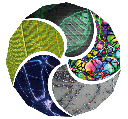Models of cell differentiation have been proposed in which cells switch from one differentiation state to another through stochastic dynamics characterized by a peak in gene expression variability at the point of fate commitment (Kupiec, 1997; Huang, 2011; Moris et al., 2016). We have tested this hypothesis at the single-cell level by measuring the expression level of selected genes by RT-qPCR at six sequential time-points after induction of differentiation of primary chicken erythroid progenitors (Gandrillon et al., 1999).
Cell-to-cell heterogeneity, hidden behind the averaging effect in populations was clearly revealed at the single-cell level. This cell-to-cell variability, as measured by entropy value, showed in a significant increase during the first hours of the differentiation process, peaking at 24h, and decreasing at 72h. Distribution-based gene correlation networks were also computed for each time-point, showing a sudden drop in correlation at 8 hours. Interestingly, such increase in cell-to-cell variability and gene correlation decrease preceded an increase in cell size variability and an irreversible commitment to differentiation.
In this work (Richard et al., 2016), we obtained strong evidence to support the idea that differentiation is not a "simple" program that all cells execute identically, but results from the dynamical behavior of the underlying molecular network (Gene Regulatory Network, or GRN), in agreement with a number of recent work (Mojtahedi et al., 2016; Stumpf et al., 2017; Semrau et al., 2017).
It would be of the highest importance to explicitly obtain the structure of that GRN. For this, we devised an advanced inference method based on the “two-state model” (Peccoud and Ycart, 1995). Individual gene expression models are used as the building blocks of our network, using a simplified hybrid formulation (Piecewise Deterministic Markov Process or PDMP; Lin and Galla, 2016) in which promoter states are discrete but where the mRNA and protein quantities are described as a continuous process. We have demonstrated the ability of this approach to successfully recover a simple toggle-switch network from simulated single-cell data (Herbach et al., 2017). This approach will give us access, not only to the existence of an interaction, but also to its direction (extracting causality) and strength.
To apply this method on our time-stamped data we will make use of a divide-and-conquer approach, that relies on an original process which splits the GRN inference issue into simpler and parallelizable recurrent subnetworks inference problems. It will be used to generate a set of GRN candidates that ultimately will be discriminated using a phase of Design Of Experiment (DOE; Kreutz and Timmer, 2009).
References
Gandrillon, O., Schmidt, U., Beug, H., and Samarut, J. (1999). TGF-beta cooperates with TGF-alpha to induce the self-renewal of normal erythrocytic progenitors: evidence for an autocrine mechanism. Embo J 18, 2764-2781.
Herbach, U., Bonnaffoux, A., Espinasse, T., and Gandrillon, O. (2017). Inferring gene regulatory networks from single-cell data: a mechanistic approach. BMC Systems Biology 11, 105.
Huang, S. (2011). Systems biology of stem cells : three useful perspectives to help overcome the paradigm of linear pathways. Philosophical transactions Series A, Mathematical, physical, and engineering sciences 366, 2247-2259.
Kreutz, C., and Timmer, J. (2009). Systems biology: experimental design. The FEBS journal 276, 923-942.
Kupiec, J.J. (1997). A Darwinian theory for the origin of cellular differentiation. Mol Gen Genet 255, 201-208.
Lin, Y.T., and Galla, T. (2016). Bursting noise in gene expression dynamics: linking microscopic and mesoscopic models. J R Soc Interface 13.
Mojtahedi, M., Skupin, A., Zhou, J., Castano, I.G., Leong-Quong, R.Y., Chang, H., Trachana, K., Giuliani, A., and Huang, S. (2016). Cell Fate Decision as High-Dimensional Critical State Transition. PLoS Biol 14, e2000640.
Moris, N., Pina, C., and Arias, A.M. (2016). Transition states and cell fate decisions in epigenetic landscapes. Nat Rev Genet 17, 693-703.
Peccoud, J., and Ycart, B. (1995). Markovian Modelling of Gene Product Synthesis. Theoretical population biology 48, 222-234.
Richard, A., Boullu, L., Herbach, U., Bonnafoux, A., Morin, V., Vallin, E., Guillemin, A., Papili Gao, N., Gunawan, R., Cosette, J., et al. (2016). Single-Cell-Based Analysis Highlights a Surge in Cell-to-Cell Molecular Variability Preceding Irreversible Commitment in a Differentiation Process. PLoS Biol 14, e1002585.
Semrau, S., Goldmann, J.E., Soumillon, M., Mikkelsen, T.S., Jaenisch, R., and van Oudenaarden, A. (2017). Dynamics of lineage commitment revealed by single-cell transcriptomics of differentiating embryonic stem cells. Nat Commun 8, 1096.
Stumpf, P.S., Smith, R.C.G., Lenz, M., Schuppert, A., Müller, F.-J., Babtie, A., Chan, T.E., Stumpf, M.P.H., Please, C.P., Howison, S.D., et al. (2017). Stem Cell Differentiation as a Non-Markov Stochastic Process. Cell Systems 5, 268–282.

 PDF version
PDF version
